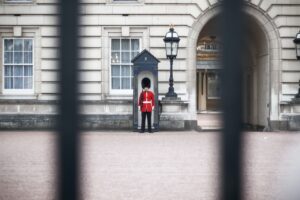The Tamed Estate - cover-up of the Queen‘s role in the Dismissal by the National Archives and The Australian
November 25, 2020
_The release of the Palace letters was pure theatre. Every element was meticulously stage-managed: the set, the props, the narrative. (From the Palace Letters pp 168-172)
_

The director-general of the National Archives, David Fricker, who had spent four years and nearly $2 million arguing against their release, and had supplied a secret submission to the court in doing so, now proclaimed the Archives to be a ‘pro-disclosure organisation’ as he presented and interpreted the letters to the public for the first time. The sheer audacity of it turned a bizarre occasion into the surreal.
In a carefully curated selection, Fricker worked his way through just nine of the 212 letters, which told a particular story – as such a limited interpretive frame must. While professing merely to be giving ‘a bit of a preview’, a gentle and benign positioning was clear. ‘I’m not a historian … archivists should not be historians,’ Fricker insisted, before proceeding as archivist qua historian to explore the handful of letters. For, at this unprecedented release of letters between a governor-general and the reigning monarch, against her express wishes and of unparalleled significance to our history, there was no historian present. It was a glaring, conspicuous exclusion.
One letter in particular, from Kerr to Charteris on 11 November 1975, after the dismissal, was highlighted as ‘an important document’ in terms of the role of the monarch at the time and whether, as Fricker termed it, ‘interventions were happening’. With Kerr’s key sentence displayed on screen, Fricker read: ‘I decided to take the step I took without informing the Palace in advance’, and noted how this critical phrase was repeated with emphasis by Charteris in his reply of 17 November 1975: ‘In NOT informing the Queen what you intended to do before doing it’. Fricker posited these post hoc assertions as central to considerations of the role of the Queen, which, in this ahistorical schema, lay in what Kerr and Charteris wrote to each other after the dismissal, rather than what was said before it.
This was performance masquerading as history, a crude exercise in setting the narrative. Even as Fricker was speaking, and forty minutes before the letters were publicly released, a News Corp journalist duly made an early call, based on that single letter from Kerr after the dismissal: ‘It was better for her Majesty NOT to know.’ It was soon followed by another hastily tweeted verdict, this time drawing on Charteris’s reply and with an accompanying image of the original letter, ‘the Queen was “NOT” informed’. News Corp’s London establishment newspaper, The Times, chimed in under the heading ‘Letters prove Queen had no part in Australia PM Gough Whitlam’s sacking’. The Daily Mail agreed: ‘The Queen DIDN’T order the Governor-General to dismiss Australian prime minister Gough Whitlam’ – as if anyone thought that she had. As tabloid journalism, it was entirely predictable; as historical analysis, it was risible.
The great disappointment in this callow charade was that after such a titanic team effort to release the letters, which were of unparalleled significance, they could be so easily reduced to the equivalent of a ‘gotcha’ moment, a headline in search of a story. It was as if the entire cache of the Palace letters, a vast and complex window on the vice-regal relationship at an unprecedented time of crisis in our history, could be read from just one letter written by the key protagonist, Sir John Kerr, after the event. The words of Chief Justice Kiefel on the limited evidentiary value of mutual assurances between Government House and Buckingham Palace that the letters were personal, written ‘conveniently after the litigation was commenced … confirming each other’s understanding’, seemed particularly apt.
Buckingham Palace soon joined the rush to its defence, issuing a rare public statement proclaiming that the letters confirmed that ‘neither Her Majesty nor the Royal Household had any part to play in Kerr’s decision’. The royal statement did not acknowledge the High Court’s landmark decision that the Palace letters were not ‘personal’ records, and instead reasserted its belief in ‘the longstanding convention that all conversations between … Governor-Generals [sic] and The Queen are private’, completely disregarding the fact that our High Court had just ruled otherwise. It was as if the Palace letters case had never happened.
The instantaneous verdict, ‘The Queen in the clear!’, could not withstand even the most cursory examination. It told us nothing about the nature of the letters, the process through which Kerr had reached his decision to dismiss the government, and, most importantly, the part played by his correspondence with the Queen in that decision. More sophisticated analyses, based on all the letters and not just one, took slightly longer to emerge, since there were 1,200 pages to work through. The Guardian’s Katharine Murphy reflected that amplifying what came after, rather than before, the dismissal, as the rush to ‘clear’ the Queen had, ‘misses the larger truth of what this profoundly important cache of correspondence lays bare … only a handful of days before the dismissal, Charteris did, in substance, intervene’.
Professor Chris Wallace concluded that the letters showed the Queen ‘providing not just comfort but actual encouragement to the governor-general in his sacking of the government’. Michael Pelly, legal editor at the Australian Financial Review, was left in no doubt that ‘the Palace gave Kerr a green light to sack Whitlam’. It is simply impossible to read these letters, with their consideration of intensely political matters, Kerr’s repeated undermining of the government, and their discussion of the use of the reserve powers to dismiss the elected government, and conclude otherwise. In Nick Feik’s blunt assessment in The Monthly, ‘No respectable historian’ could accept that the Queen played ‘no role’ in Kerr’s decision to dismiss Whitlam.
The Palace letters are the most significant historical records about the dismissal, and the only ones to explore the real-time communications between the governor-general and the Queen over the critical months during which Kerr reached his decision to dismiss the government and appoint the opposition in its place. They provide a remarkable insight into Kerr’s views of the unfolding political situation, his fear of his own recall, his frailties, his need for royal approbation, and his planning for and eventual decision to dismiss the government. In doing so, Kerr acted unilaterally, in a vice-regal capacity as the Queen’s representative in Australia, using the contentious ‘reserve powers of the Crown’ to dismiss an elected government in a raw display of residual quasi-imperial power.
In this post-colonial penumbra of unregulated vice-regal action, it was inevitable that the lingering question would be whether the Queen had played any role in Kerr’s decision to dismiss the Whitlam government. The Palace letters were finally about to answer that critical question.
As a physical archive, the Palace letters reveal much that is lost in their homogenous representation in digital form.
The above is an edited extract from The Palace Letters: The Queen, the governor-general, and the plot to dismiss Gough Whitlam by Jenny Hocking (Scribe, $32.99)
Comment by John Menadue.
The evidence in the Palace Letters is quite clear. The Queen, Martin Charteris and John Kerr collaborated in deceiving the Australian Prime Minister. They knowingly engineered his Dismissal. What a disgraceful performance by them all. No wonder the Queen went to great lengths to keep her role secret.
